ECO mode Citroen C4 DAG 2013.5 2.G User Guide
[x] Cancel search | Manufacturer: CITROEN, Model Year: 2013.5, Model line: C4 DAG, Model: Citroen C4 DAG 2013.5 2.GPages: 340, PDF Size: 28.95 MB
Page 52 of 340
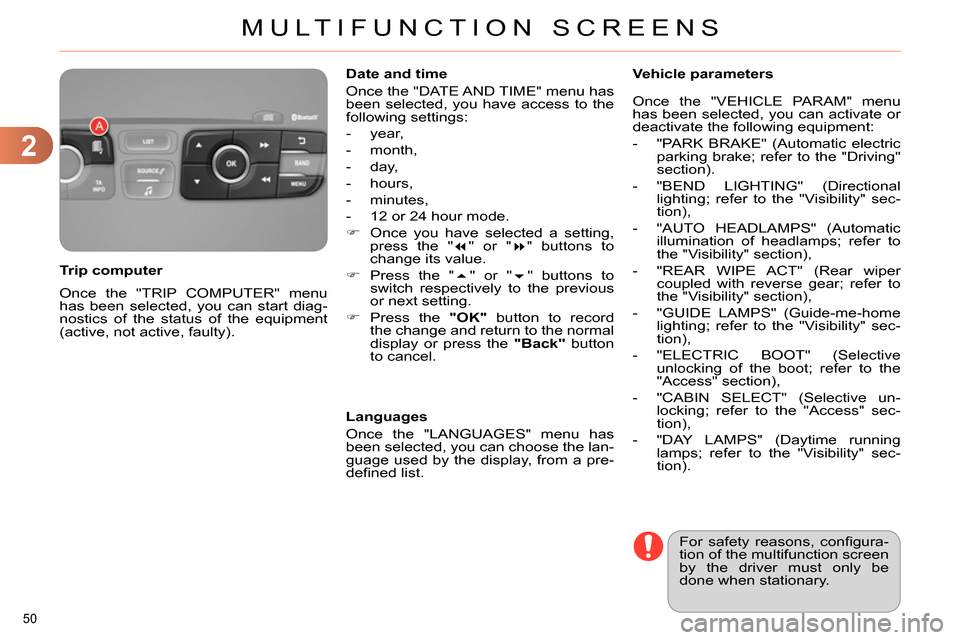
2
MULTIFUNCTION SCREENS
50
Once the "TRIP COMPUTER" menu
has been selected, you can start diag-
nostics of the status of the equipment
(active, not active, faulty).
Trip computer
Date and time
Once the "DATE AND TIME" menu has
been selected, you have access to the
following settings:
- year,
- month,
- day,
- hours,
- minutes,
- 12 or 24 hour mode.
Once you have selected a setting,
press the "
" or "
" buttons to
change its value.
Press the "
" or "
" buttons to
switch respectively to the previous
or next setting.
Press the "OK"
button to record
the change and return to the normal
display or press the "Back"
button
to cancel.
Languages
Once the "LANGUAGES" menu has
been selected, you can choose the lan-
guage used by the display, from a pre-
defi ned list.
For safety reasons, confi gura-
tion of the multifunction screen
by the driver must only be
done when stationary.
Vehicle parameters
Once the "VEHICLE PARAM" menu
has been selected, you can activate or
deactivate the following equipment:
- "PARK BRAKE" (Automatic electric
parking brake; refer to the "Driving"
section).
- "BEND LIGHTING" (Directional
lighting; refer to the "Visibility" sec-
tion),
- "AUTO HEADLAMPS" (Automatic
illumination of headlamps; refer to
the "Visibility" section),
- "REAR WIPE ACT" (Rear wiper
coupled with reverse gear; refer to
the "Visibility" section),
- "GUIDE LAMPS" (Guide-me-home
lighting; refer to the "Visibility" sec-
tion),
- "ELECTRIC BOOT" (Selective
unlocking of the boot; refer to the
"Access" section),
- "CABIN SELECT" (Selective un-
locking; refer to the "Access" sec-
tion),
- "DAY LAMPS" (Daytime running
lamps; refer to the "Visibility" sec-
tion).
Page 61 of 340
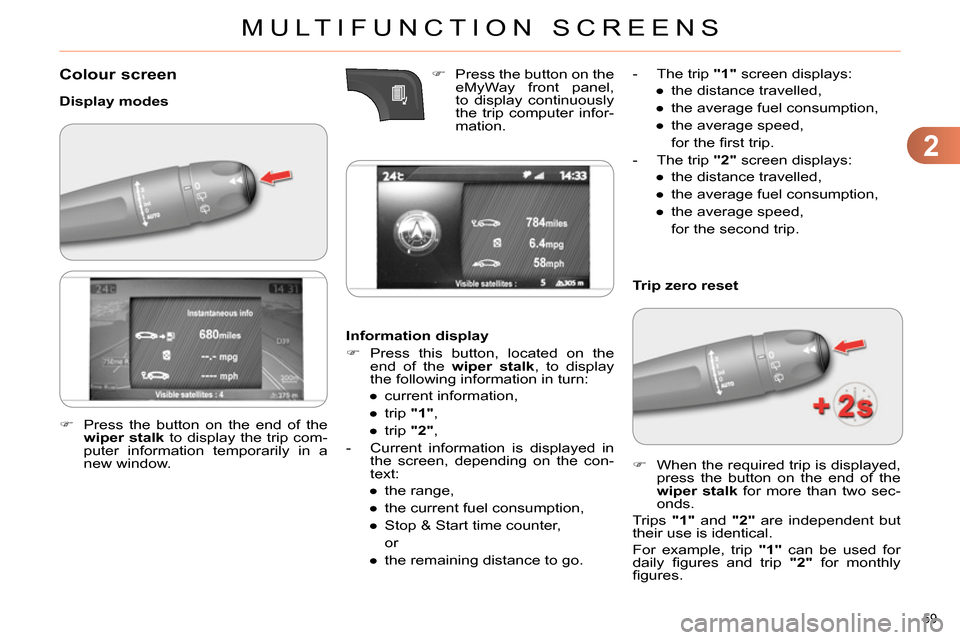
2
MULTIFUNCTION SCREENS
59
Colour screen
Display modes
Information display
Press this button, located on the
end of the wiper stalk
, to display
the following information in turn:
●
current information,
●
trip "1"
,
●
trip "2"
,
- Current information is displayed in
the screen, depending on the con-
text:
●
the range,
●
the current fuel consumption,
●
Stop & Start time counter,
or
●
the remaining distance to go.
Trip zero reset
When the required trip is displayed,
press the button on the end of the
wiper stalk
for more than two sec-
onds.
Trips "1"
and "2"
are independent but
their use is identical.
For example, trip "1"
can be used for
daily fi gures and trip "2"
for monthly
fi gures.
Press the button on the end of the
wiper stalk
to display the trip com-
puter information temporarily in a
new window.
Press the button on the
eMyWay front panel,
to display continuously
the trip computer infor-
mation.
- The trip "1"
screen displays:
●
the distance travelled,
●
the average fuel consumption,
●
the average speed,
for the
fi rst trip.
- The trip "2"
screen displays:
●
the distance travelled,
●
the average fuel consumption,
●
the average speed,
for the second trip.
Page 62 of 340
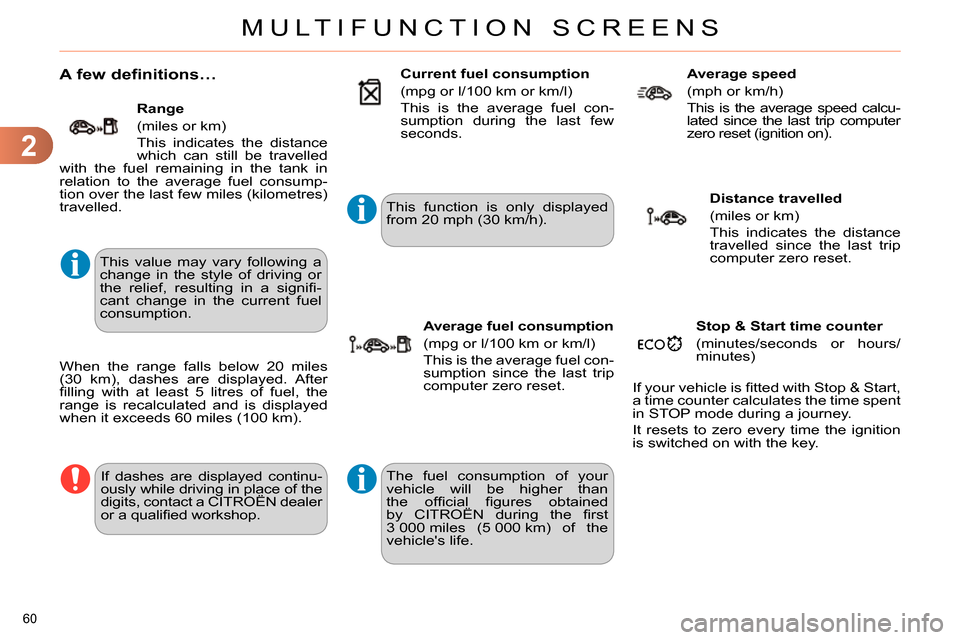
2
MULTIFUNCTION SCREENS
60
A few definitions…
This value may vary following a
change in the style of driving or
the relief, resulting in a signifi -
cant change in the current fuel
consumption.
If dashes are displayed continu-
ously while driving in place of the
digits, contact a CITROËN dealer
or a qualifi ed workshop. This function is only displayed
from 20 mph (30 km/h).
Range
(miles or km)
This indicates the distance
which can still be travelled
with the fuel remaining in the tank in
relation to the average fuel consump-
tion over the last few miles (kilometres)
travelled.
When the range falls below 20 miles
(30 km), dashes are displayed. After
fi lling with at least 5 litres of fuel, the
range is recalculated and is displayed
when it exceeds 60 miles (100 km).
Current fuel consumption
(mpg or l/100 km or km/l)
This is the average fuel con-
sumption during the last few
seconds.
Average fuel consumption
(mpg or l/100 km or km/l)
This is the average fuel con-
sumption since the last trip
computer zero reset.
Average speed
(mph or km/h)
This is the average speed calcu-
lated since the last trip computer
zero reset (ignition on).
Distance travelled
(miles or km)
This indicates the distance
travelled since the last trip
computer zero reset.
Stop & Start time counter
(minutes/seconds or hours/
minutes)
If your vehicle is fi tted with Stop & Start,
a time counter calculates the time spent
in STOP mode during a journey.
It resets to zero every time the ignition
is switched on with the key.
The fuel consumption of your
vehicle will be higher than
the offi cial fi gures obtained
by CITROËN during the fi rst
3 000 miles (5 000 km) of the
vehicle's life.
Page 67 of 340
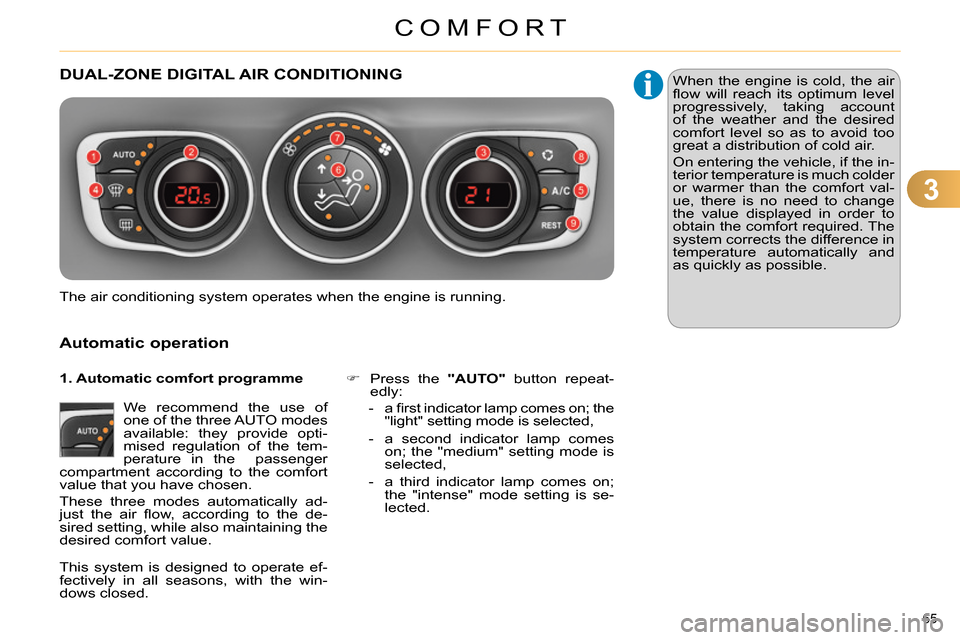
3
COMFORT
65
DUAL-ZONE DIGITAL AIR CONDITIONING
Automatic operation
We recommend the use of
one of the three AUTO modes
available: they provide opti-
mised regulation of the tem-
perature in the passenger
compartment according to the comfort
value that you have chosen.
These three modes automatically ad-
just the air fl ow, according to the de-
sired setting, while also maintaining the
desired comfort value.
Press the "AUTO"
button repeat-
edly:
- a fi rst indicator lamp comes on; the
"light" setting mode is selected,
- a second indicator lamp comes
on; the "medium" setting mode is
selected,
- a third indicator lamp comes on;
the "intense" mode setting is se-
lected.
The air conditioning system operates when the engine is running. When the engine is cold, the air
fl ow will reach its optimum level
progressively, taking account
of the weather and the desired
comfort level so as to avoid too
great a distribution of cold air.
On entering the vehicle, if the in-
terior temperature is much colder
or warmer than the comfort val-
ue, there is no need to change
the value displayed in order to
obtain the comfort required. The
system corrects the difference in
temperature automatically and
as quickly as possible.
1. Automatic comfort programme
This system is designed to operate ef-
fectively in all seasons, with the win-
dows closed.
Page 94 of 340
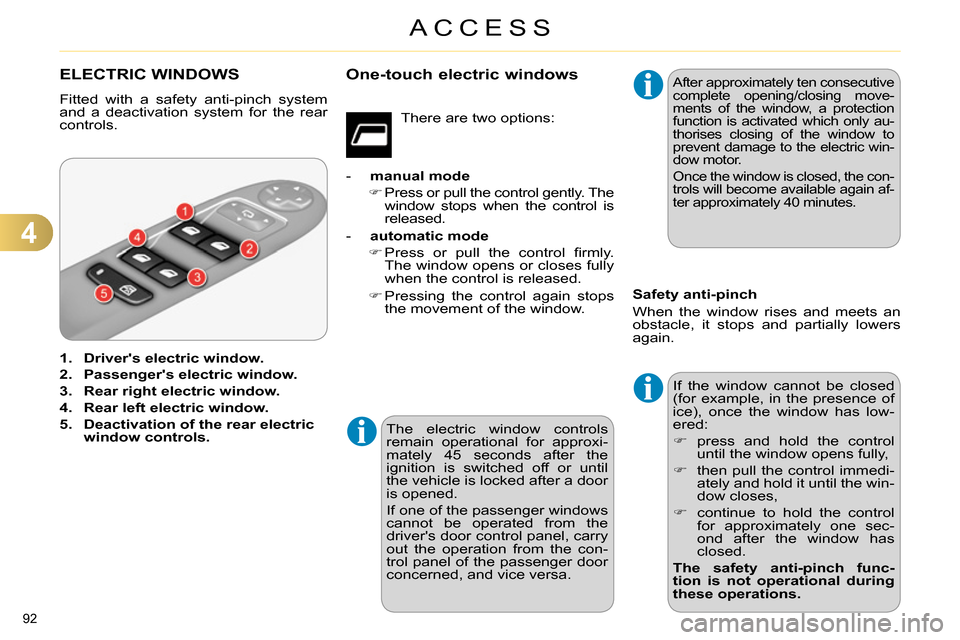
4
ACCESS
92
ELECTRIC WINDOWS
Fitted with a safety anti-pinch system
and a deactivation system for the rear
controls.
1.
Driver's electric window.
2.
Passenger's electric window.
3.
Rear right electric window.
4.
Rear left electric window.
5.
Deactivation of the rear electric
window controls.
The electric window controls
remain operational for approxi-
mately 45 seconds after the
i gnition is switched off or until
the vehicle is locked after a door
is opened.
If one of the passenger windows
cannot be operated from the
driver's door control panel, carry
out the operation from the con-
trol panel of the passenger door
concerned, and vice versa.
After approximately ten consecutive
complete opening/closing move-
ments of the window, a protection
function is activated which only au-
thorises closing of the window to
prevent damage to the electric win-
dow motor.
Once the window is closed, the con-
trols will become available again af-
ter approximately 40 minutes.
If the window cannot be closed
(for example, in the presence of
ice), once the window has low-
ered:
press and hold the control
until the window opens fully,
then pull the control immedi-
ately and hold it until the win-
dow closes,
continue to hold the control
for approximately one sec-
ond after the window has
closed.
The safety anti-pinch func-
tion is not operational during
these operations.
There are two options:
- manual mode
Press or pull the control gently. The
window stops when the control is
released.
- automatic mode
Press or pull the control fi rmly.
The window opens or closes fully
when the control is released.
Pressing the control again stops
the movement of the window.
Safety anti-pinch
When the window rises and meets an
obstacle, it stops and partially lowers
again.
One-touch electric windows
Page 102 of 340
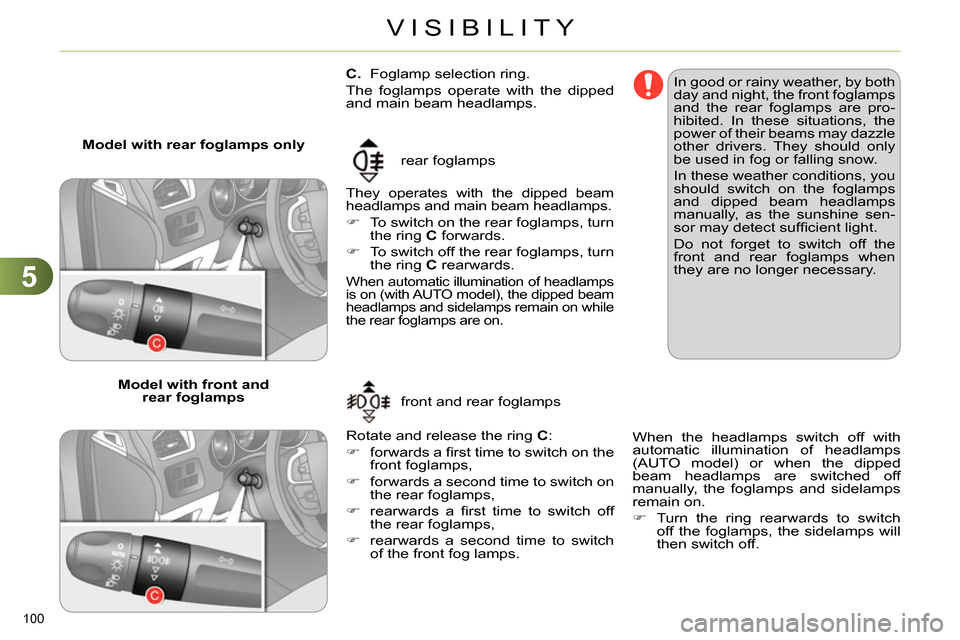
5
VISIBILITY
100
C.
Foglamp selection ring.
The foglamps operate with the dipped
and main beam headlamps.
They operates with the dipped beam
headlamps and main beam headlamps.
To switch on the rear foglamps, turn
the ring C
forwards.
To switch off the rear foglamps, turn
the ring C
rearwards.
When automatic illumination of headlamps
is on (with AUTO model), the dipped beam
headlamps and sidelamps remain on while
the rear foglamps are on.
Model with rear foglamps only
rear foglamps
Rotate and release the ring C
:
forwards a fi rst time to switch on the
front foglamps,
forwards a second time to switch on
the rear foglamps,
rearwards a fi rst time to switch off
the rear foglamps,
rearwards a second time to switch
of the front fog lamps.
Model with front and
rear foglamps
front and rear foglamps
When the headlamps switch off with
automatic illumination of headlamps
(AUTO model) or when the dipped
beam headlamps are switched off
manually, the foglamps and sidelamps
remain on.
Turn the ring rearwards to switch
off the foglamps, the sidelamps will
then switch off.
In good or rainy weather, by both
day and night, the front foglamps
and the rear foglamps are pro-
hibited. In these situations, the
power of their beams may dazzle
other drivers. They should only
be used in fog or falling snow.
In these weather conditions, you
should switch on the foglamps
and dipped beam headlamps
manually, as the sunshine sen-
sor may detect suffi cient light.
Do not forget to switch off the
front and rear foglamps when
they are no longer necessary.
Page 103 of 340
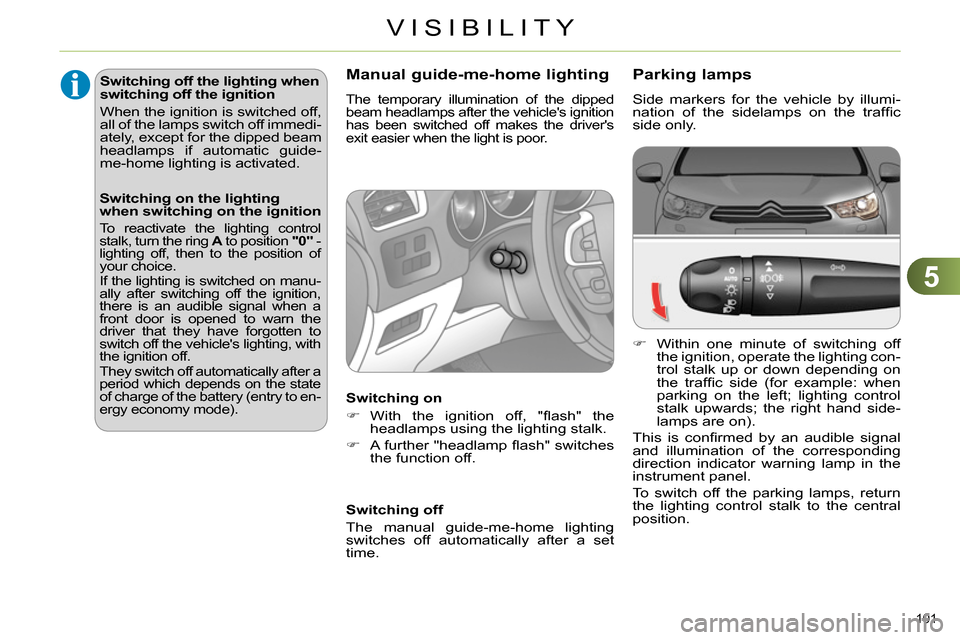
5
VISIBILITY
101
Parking lamps
Side markers for the vehicle by illumi-
nation of the sidelamps on the traffi c
side only.
Within one minute of switching off
the ignition, operate the lighting con-
trol stalk up or down depending on
the traffi c side (for example: when
parking on the left; lighting control
stalk upwards; the right hand side-
lamps are on).
This is confi rmed by an audible signal
and illumination of the corresponding
direction indicator warning lamp in the
instrument panel.
To switch off the parking lamps, return
the lighting control stalk to the central
position.
Switching off the lighting when
switching off the ignition
When the ignition is switched off,
all of the lamps switch off immedi-
ately, except for the dipped beam
headlamps if automatic guide-
me-home lighting is activated.
Manual guide-me-home lighting
The temporary illumination of the dipped
beam headlamps after the vehicle's ignition
has been switched off makes the driver's
exit easier when the light is poor.
Switching on
With the ignition off, "fl ash" the
headlamps using the lighting stalk.
A further "headlamp fl ash" switches
the function off.
Switching off
The manual guide-me-home lighting
switches off automatically after a set
time.
Switching on the lighting
when switching on the ignition
To reactivate the lighting control stalk, turn the ring A
to position "0"
- lighting off, then to the position of
your choice.
If the lighting is switched on manu-
ally after switching off the ignition,
there is an audible signal when a
front door is opened to warn the
driver that they have forgotten to
switch off the vehicle's lighting, with
the ignition off.
They switch off automatically after a
period which depends on the state
of charge of the battery (entry to en-
ergy economy mode).
Page 112 of 340
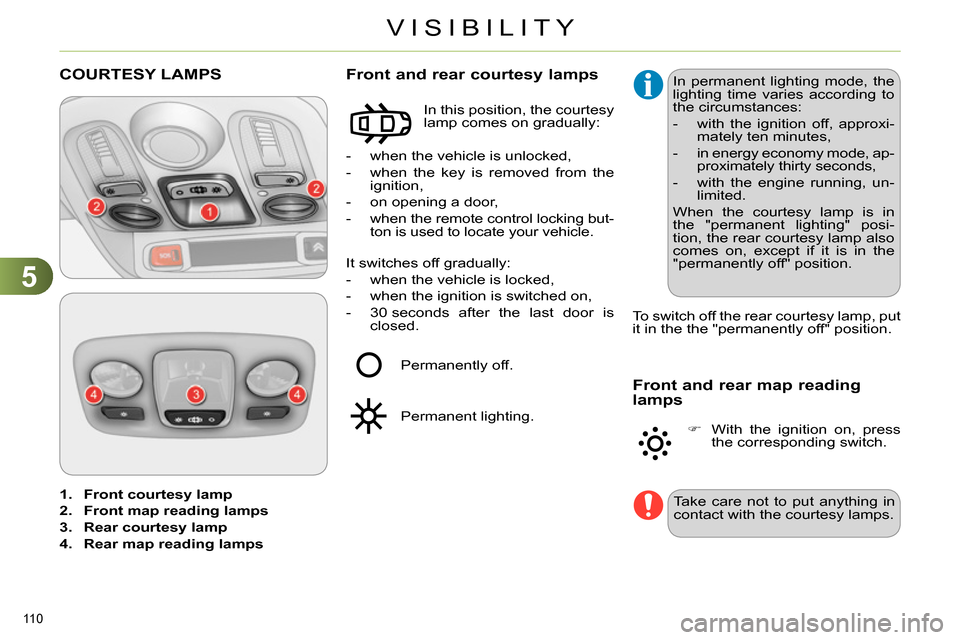
5
VISIBILITY
110
1.
Front courtesy lamp
2.
Front map reading lamps
3.
Rear courtesy lamp
4.
Rear map reading lamps
COURTESY LAMPS
- when the vehicle is unlocked,
- when the key is removed from the
ignition,
- on opening a door,
- when the remote control locking but-
ton is used to locate your vehicle.
Front and rear courtesy lamps
In this position, the courtesy
lamp comes on gradually:
It switches off gradually:
- when the vehicle is locked,
- when the ignition is switched on,
- 30 seconds after the last door is
closed. To switch off the rear courtesy lamp, put
it in the the "permanently off" position.
Permanently off.
Permanent lighting. In permanent lighting mode, the
lighting time varies according to
the circumstances:
- with the ignition off, approxi-
mately ten minutes,
- in energy economy mode, ap-
proximately thirty seconds,
- with the engine running, un-
limited.
When the courtesy lamp is in
the "permanent lighting" posi-
tion, the rear courtesy lamp also
comes on, except if it is in the
"permanently off" position.
Front and rear map reading
lamps
Take care not to put anything in
contact with the courtesy lamps.
With the ignition on, press
the corresponding switch.
Page 113 of 340
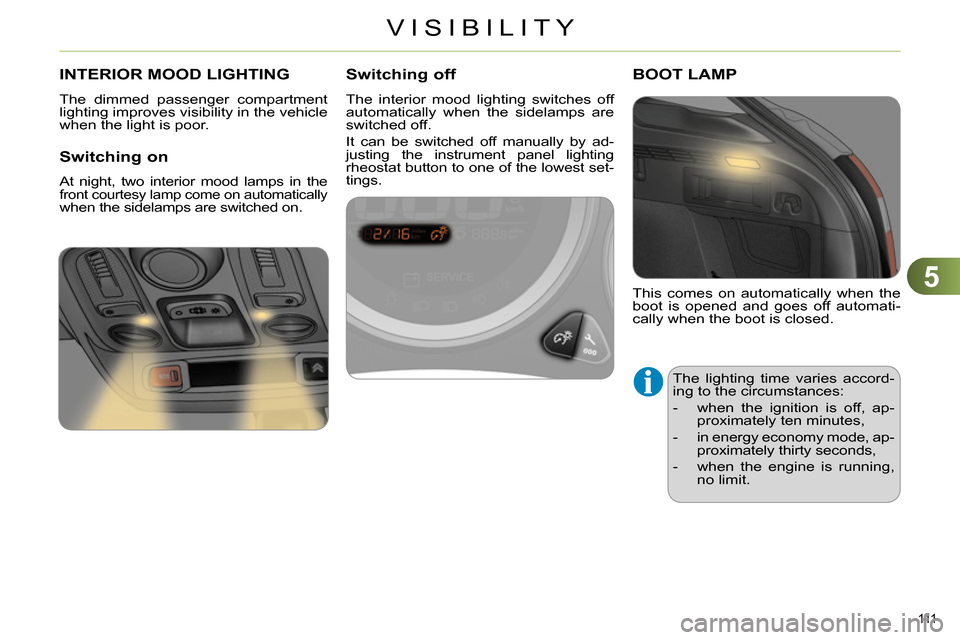
5
VISIBILITY
111
INTERIOR MOOD LIGHTING
The dimmed passenger compartment
lighting improves visibility in the vehicle
when the light is poor.
Switching on
At night, two interior mood lamps in the front courtesy lamp come on automatically
when the sidelamps are switched on.
Switching off
The interior mood lighting switches off
automatically when the sidelamps are
switched off.
It can be switched off manually by ad-
justing the instrument panel lighting
rheostat button to one of the lowest set-
tings.
This comes on automatically when the
boot is opened and goes off automati-
cally when the boot is closed.
BOOT LAMP
The lighting time varies accord-
ing to the circumstances:
- when the ignition is off, ap-
proximately ten minutes,
- in energy economy mode, ap-
proximately thirty seconds,
- when the engine is running,
no limit.
Page 141 of 340
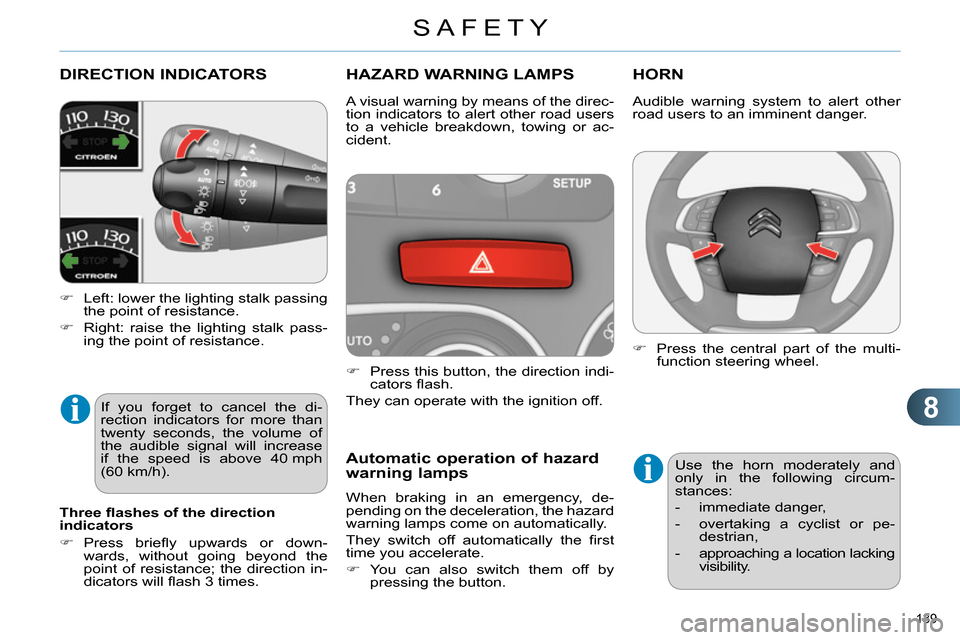
8
SAFETY
139
DIRECTION INDICATORS
Left: lower the lighting stalk passing
the point of resistance.
Right: raise the lighting stalk pass-
ing the point of resistance.
HAZARD WARNING LAMPS
Press this button, the direction indi-
cators fl ash.
They can operate with the ignition off.
Automatic operation of hazard
warning lamps
When braking in an emergency, de-
pending on the deceleration, the hazard
warning lamps come on automatically.
They switch off automatically the fi rst
time you accelerate.
You can also switch them off by
pressing the button.
HORN
A visual warning by means of the direc-
tion indicators to alert other road users
to a vehicle breakdown, towing or ac-
cident.
Three fl ashes of the direction
indicators
Press briefl y upwards or down-
wards, without going beyond the
point of resistance; the direction in-
dicators will fl ash 3 times.
If you forget to cancel the di-
rection indicators for more than
twenty seconds, the volume of
the audible signal will increase
if the speed is above 40 mph
(60 km/h). Audible warning system to alert other
road users to an imminent danger.
Press the central part of the multi-
function steering wheel.
Use the horn moderately and
only in the following circum-
stances:
- immediate danger,
- overtaking a cyclist or pe-
destrian,
- approaching a location lacking
visibility.